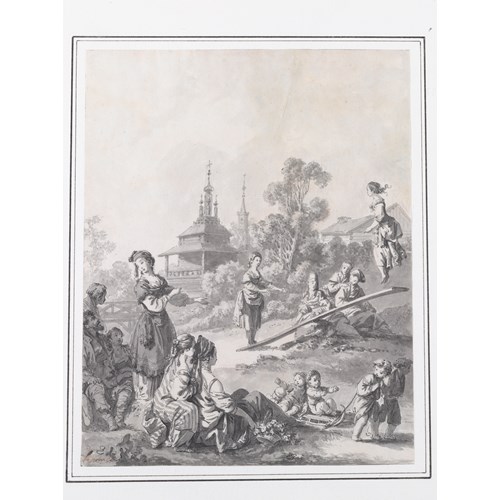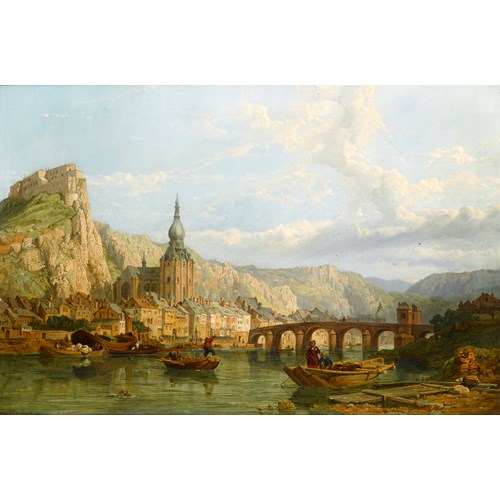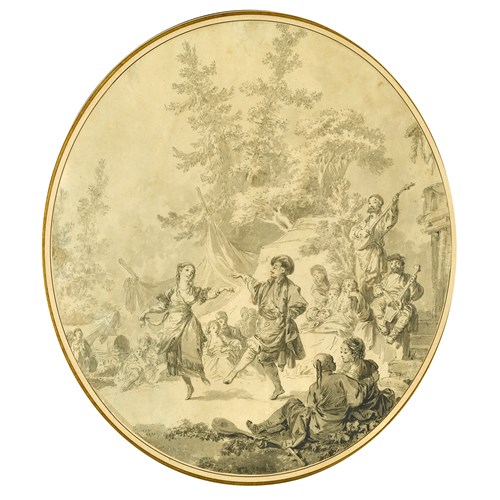Marketplace
The Cathedral of Prince St. Vladimir
Alfred Gomersal Vickers
The Cathedral of Prince St. Vladimir
Date 1830s
Epoque 1750-1850, 19th century
Origine England
Medium Watercolour, Gum arabic, On paper
Dimension 24.5 x 37.5 cm (9⁵/₈ x 14³/₄ inches)
Rising from its flooded surroundings, the majestic form of the Cathedral of Prince St. Vladimir in St. Petersburg dominates the skyline. In the foreground a number of barges and boats are anchored, waiting for the waters of the River Neva to subside. The figures chat amongst themselves and carry out a few repairs but are largely helpless in the present conditions. The waters have not quite reached the cathedral itself and such is its vast bulk that it is hard to imagine it being subservient to the elements. Its spires eclipse all other buildings on the horizon and draw the eye to the dramatic sky, where dark clouds gathering on the right-hand side carry the threat of more bad weather ahead.
The first church on the present site was built in 1708, although the edifice depicted here by Alfred Gomersal Vickers originated from the 1765 structure by Antonio Rinaldi (1709-1794). The design of the church, with its five domes and three-tiered belfry, is considered to be a fine illustration of the transition from the Baroque to Classicism in Russian architecture. The cathedral had originally been dedicated to St. Nicholas, but in 1789 it was re-consecrated to St. Vladimir.
Throughout the ages, flooding has been a major problem for St. Petersburg, as much of the city was built just a few feet above sea-level. The Cathedral of Prince St. Vladimir, St. Petersburg was probably painted in the 1830s: during this decade floods were recorded almost every year. The marshy lowlands, where the Cathedral of Prince St. Vladimir was built, are particularly at risk from the rising waters. Vickers was clearly inspired by the view of St. Petersburg’s magnificent buildings surrounded by large expanses of water; The Winter Palace at St. Petersburg, Russia (Private Collection) is another example of such a depiction.
Vickers was the son of self-taught landscape painter Alfred Vickers (1786-1868). Like his father he painted landscapes and used similar techniques for the depiction of skies, water and light. In 1833 Charles Heath (1785-1848), a landscape and figure engraver, sent Vickers to Russia to make drawings and paintings of his experiences there. Heath was one of the most influential figures in British book production in the first half of the nineteenth century. He engraved Vickers’ works executed in Russia and used them to illustrate The Annuals. Together they also provided illustrations for A Journey to St. Petersburg and Moscow through Courland and Livonia (1836) by Leitch Ritchie. Although there is no etched version of The Church of St. Nicholas, St. Petersburg in the book, many of the etchings are comparable to the present work, in that they represent a historical monument of St. Petersburg and simultaneously give the viewer a feeling of the city’s atmosphere through the depictions of local people.
The first church on the present site was built in 1708, although the edifice depicted here by Alfred Gomersal Vickers originated from the 1765 structure by Antonio Rinaldi (1709-1794). The design of the church, with its five domes and three-tiered belfry, is considered to be a fine illustration of the transition from the Baroque to Classicism in Russian architecture. The cathedral had originally been dedicated to St. Nicholas, but in 1789 it was re-consecrated to St. Vladimir.
Throughout the ages, flooding has been a major problem for St. Petersburg, as much of the city was built just a few feet above sea-level. The Cathedral of Prince St. Vladimir, St. Petersburg was probably painted in the 1830s: during this decade floods were recorded almost every year. The marshy lowlands, where the Cathedral of Prince St. Vladimir was built, are particularly at risk from the rising waters. Vickers was clearly inspired by the view of St. Petersburg’s magnificent buildings surrounded by large expanses of water; The Winter Palace at St. Petersburg, Russia (Private Collection) is another example of such a depiction.
Vickers was the son of self-taught landscape painter Alfred Vickers (1786-1868). Like his father he painted landscapes and used similar techniques for the depiction of skies, water and light. In 1833 Charles Heath (1785-1848), a landscape and figure engraver, sent Vickers to Russia to make drawings and paintings of his experiences there. Heath was one of the most influential figures in British book production in the first half of the nineteenth century. He engraved Vickers’ works executed in Russia and used them to illustrate The Annuals. Together they also provided illustrations for A Journey to St. Petersburg and Moscow through Courland and Livonia (1836) by Leitch Ritchie. Although there is no etched version of The Church of St. Nicholas, St. Petersburg in the book, many of the etchings are comparable to the present work, in that they represent a historical monument of St. Petersburg and simultaneously give the viewer a feeling of the city’s atmosphere through the depictions of local people.
Date: 1830s
Epoque: 1750-1850, 19th century
Origine: England
Medium: Watercolour, Gum arabic, On paper
Signature: Inscribed 'Church of St. Nicholas of The Bath and part of the port line bridge. Petersburg' (on the reverse).
Dimension: 24.5 x 37.5 cm (9⁵/₈ x 14³/₄ inches)
Plus d'œuvres d'art de la Galerie




 The Harvest_T638810975891048810.jpg?width=500&height=500&mode=pad&scale=both&qlt=90&format=jpg)




